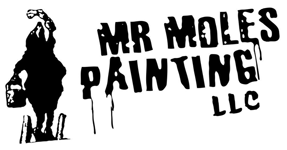A fresh coat of paint is an excellent way to make your home look clean and updated. While anyone can pick up a roller and paint a room, many DIYers quickly get in over their heads. Achieving a flawless finish is not as easy as home renovation shows make it look. The paint colors you choose, sheen, and application techniques can result in streaky and uneven surfaces.
Common Painting Mistakes to Avoid
1. Using Light Paint Colors
If you have a busy household and are worried about dirty walls, bright white is the least forgiving paint color. Any marks or stains will stand out on light-colored walls. Choose a mid-tone neutral paint color that helps hide dirt and minor imperfections. A warm “greige” color can help hide fingerprints in high-traffic areas. A cooler neutral will also provide good coverage while keeping a space light and bright.
2. Buying Cheap Paint Products
For the best finish, using high-quality paint is a must. The higher price you pay for premium paint is worth the outcome. Higher-quality paints hide imperfections and last longer. Consider using premium paint for better coverage and a longer-lasting finish in areas where durability is essential, such as kitchens, bathrooms, and hallways. Most paint manufacturers offer products that are durable, washable, and scrubbable.
3. Selecting the Wrong Sheen
A paint’s sheen or gloss, which refers to how reflective the finish appears, can significantly impact durability. The shinier finishes, including semi-gloss and high-gloss, are more durable and easier to clean. A glossier surface can handle frequent cleaning, so these sheens work well on cabinetry and trim. Washing walls with a flat or matte finish requires a gentle touch, as cleaning products and scrubbing can damage the finish. Non-reflective or matte paint finishes work best in low-traffic areas that don’t gather too many scuffs or splatters. An eggshell finish is easy to wipe clean and can be an excellent choice for most areas, including kitchens and bathrooms.
4. Rushing or Avoiding Preparation
Proper preparation is key to achieving a high-quality finish, and cleaning walls is the first step. Use a mixture of warm water and trisodium phosphate (TSP) to wipe down walls and remove dirt, dust, and grime. Any holes, cracks, or dents should be repaired with spackle and sanded smooth. After repairs are complete, clean the walls again to remove all sanding dust. Thoroughly vacuum or sweep the room, remove large furniture or cover it with tarps, and remove everything from the walls.
5. Skipping Primer
Primer helps create a uniform base, conceals imperfections, and helps ensure a flawless finish. Some primers have special formulas designed to cover stains and prevent stains from bleeding through your new paint color. Pay attention to the label and select the correct primer for the surface you are painting, such as drywall, plaster, masonry, or raw wood. Tinted primer does a better job concealing patched areas and covering up the old paint color. As a result, the new paint color will be more vibrant and may require fewer coats. This is especially true when painting over darker colors like orange or red, which could require three or more topcoats if you don’t first apply a tinted primer.
6. Using the Wrong Tools
Avoid using old brushes and other tools you may have around the house. Buy the best rollers and brushes you can afford. Pay attention to the type of brush or roller recommended for the paint you are using. The best tool for the project also depends on the type of surface. Smooth surfaces require rollers with a thin nap, while rougher surfaces, such as brick walls, require a thickly woven roller that can hold more paint and get into all crevices.
7. Poor Painting Techniques
One coat is rarely enough to create a professional-looking finish. You can’t apply two coats of paint one after the other. For the best results, you’ll need to wait several hours until the first coat is completely dry, which will vary depending on your environment. Painting in high humidity or cooler temperatures often means longer dry and recoat times. Moisture and heat can prevent the topcoat from properly adhering, leading to paint bubbles. It’s essential to read and follow the directions on the paint you select. If you’ve never painted a room before, there are helpful video tutorials available online.
Hire a Professional
Home improvement projects can be exciting, but they can also be stressful. Hiring a professional team to take care of your painting project allows you to sit back and enjoy the outcome. Unless you are a skilled painter, it takes significant time and practice to achieve professional results. Painting even one small room can be a task that takes multiple days to complete on your own. A large project that can take a homeowner several weeks (and all of their spare time) may only take a professional painter a few days to complete.
Trust the Local Painting Professionals
The benefits of hiring a professional painting contractor are numerous. You’ll save time, energy, and money and have peace of mind knowing that the work has been completed safely and professionally. By hiring local painting professionals, you’ll benefit from their expertise and support your local community at the same time.
Mr. Mole’s Painting LLC offers interior and exterior painting services for commercial and residential properties. We provide in-person and virtual quotes for your convenience. Contact us today at (25-7168) to discuss your painting project.
